
It’s officially spring and there’s no other destination as unique as Japan to enjoy the warmer weather. From temples to cherry blossoms, to hip cities and shopping, Japan has something to offer for everyone.
Japan’s Cherry Blossom Festival
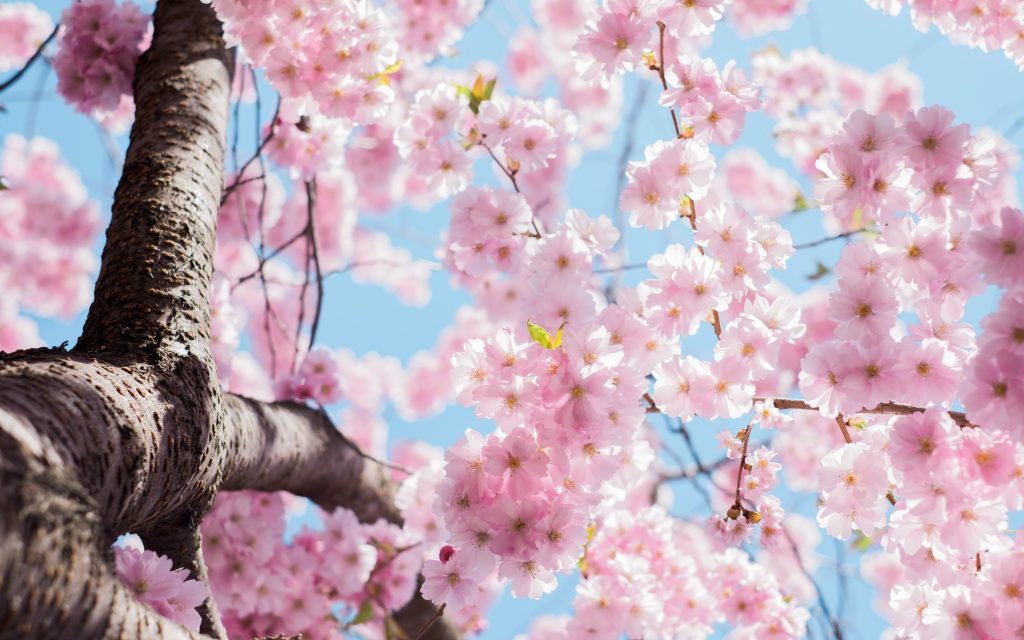
Japan’s Cherry Blossom Festival offers a variety of impressive cherry blossoms. The famous cherry blossom festival season begins around the end of March. It lasts for approximately 2 weeks, depending on location. Cherry trees can bloom right through until May the further north you travel. Dedicated sakura viewers can head north to enjoy even more sakura spotting.
Top viewing spots like Maruyama Park, Mount Yoshino, Himeji Castle, and Fuji Five Lakes; are some of the most atmospheric places in the world. They are wonderful places to see the beautiful blooms. For those who would like to enjoy a more scaled-down celebration of spring; there are plenty of lesser-known viewing spots where visitors can picnic in peace.
Popularity
The aristocrats of days gone by often wrote poetry or painted pictures to celebrate the beauty of the cherry blossom. These days, viewings are more about eating, drinking, and coming together to celebrate the beginning of spring.
Public parks, rivers, and other attractions where cherry trees are found will fill up; with the smell of barbecue, food stalls, and the sound of celebrations during the season. So popular are the seasonal festivities. It can be hard to find a space in some of the more popular viewing locations.
Significance of the Cherry Blossom
Cherry blossoms, known in Japan as sakura, are well known around the world for their radiant, delicate and transient beauty. However they are more than simply beautiful trees, as sakura have strong ties to Japan’s history, culture and identity. Originally used to divine the year’s harvest; sakura came to embody wabi-sabi philosophy. It also symbolizes Shinto ideals of impermanence, hope and renewal and are now one of Japan’s most iconic natural symbols.
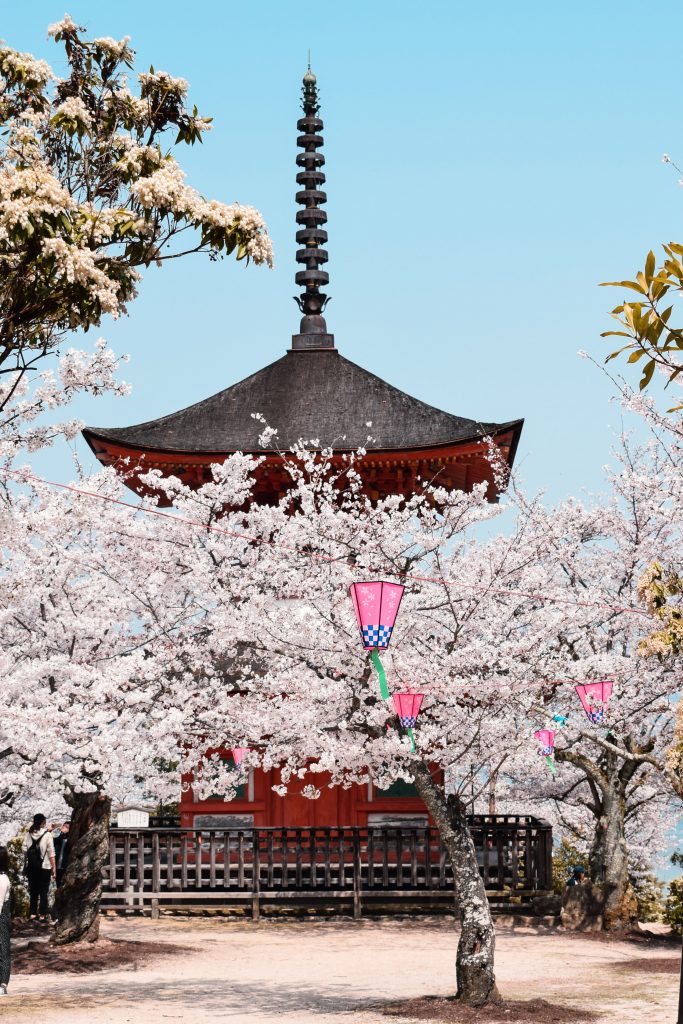
Adding to their magic and mystique, sakura are usually only in full bloom for around one week. Across the diverse landscape of Japan’s main islands, this magical moment can occur between March to early May. After the brief period of full bloom, the small, delicate flowers start to flutter gracefully from their trees. The blossoms are said to be the most beautiful in this final stage; as the white and pink petals gently float to the ground.
Symbolism
For many Japanese, the blooming of the cherry blossom trees symbolises human life, transience and nobleness. The Japanese love to celebrate and cherish the cherry blossoms trees. During the limited flowering period and many people hold ‘flower watching’ parties known as hanami. You simply cannot travel to Japan in spring without appreciating the beauty of the sakura; and experiencing a hanami party for yourself!
Given the cultural significance of the sakura; there are countless events, festivals, and speciality tours that centred around the blooming of the cherry blossoms.
History
The blossom viewing in Japan is believed to have first started in the Nara period of the country’s history. That is between 710 A.D. and 794 A.D. The ancient farmers also used the blooming of the sakura flowers. They used them to understand when the time was right to plant their rice crops, helping to keep famine at bay.
Fast forward a few hundred years and the family members and the courtiers of the most important imperial families; made it fashionable to hold gatherings to celebrate the occasion of the annual new bloom at the beginning of spring.
When is Cherry Blossom Period?
The exact dates for the cherry blossom season in Japan vary depending on where in the country you are headed. Most trees only bloom for a few days. So it’s important to know when the best time to visit each of the different locations will be. You should also be aware that there will usually be a few days between the date of the first bloom and the date of the full bloom.
Poor winter conditions can add a week to either side of the expected dates. However, as a general rule of thumb, the milder the climate, the earlier in the year the blossoms will open.
There is plenty of information available to help track the forecast for the cherry blossom season. From local websites and news reports to tracking apps; there is no reason for you to miss the start of the season.
Hanami
In ancient times, farmers would pray, make offerings, and have a feast; believing that cherry blossom trees would bring a full harvest. The feast under the tree was similar to a religious ceremony. It slowly changed into a festival for enjoying cherry blossoms in the Nara period (710~794). During the Heian period (794~1192), the cherry blossom appeared in many waka poems. The flower became a national image to the Japanese. During the Edo period (1603~1868), common citizens started having banquets under the trees.
Nowadays, Hanami is held as an annual event everybody longs for. Friends, families, company members, and all sorts of groups gather in parks and have picnics under the cherry blossoms. As often during Japanese parties, alcoholic drinks are involved; which can ease participation in popular activities such as singing karaoke songs on portable devices. In parks, numerous food stalls provide catering, and in bigger places you can assist in music and dance shows. Amateur photographers take their best camera out and compete for the best photo spots; while the common passersby use their smartphone to immortalize the fleeting beauty of the flowers. This can go into the night for yozakura. The term for admiring the sakura at night; when most popular hanami places are usually lit up with decorative lanterns or spot lights.
Tokyo
If you are looking for a more urban feel and less flower watching, Tokyo is a great place to visit. Tokyo is huge, it’s busy and it’s loud. But it is also incredibly safe for travellers of any kind. Crimes are a rarity here. Crimes against tourists are almost unheard of. This is not just an opinion. Tokyo regularly features at the top of lists discussing safety or low crime rates. You may accept that Tokyo is more lit up than say Piccadilly Circus or Times Square for example. But even more so than Las Vegas?! It is. It has far more streets than Las Vegas. More often than not the entire street is ablaze with neon lights.
Places to Visit
Tokyo Tower
The other iconic landmark dominating the skyline of Tokyo is the red and white Tokyo Tower. Adding a touch of French flair to the streets of Tokyo. The 333m tall broadcasting tower has thousands of visitors every year since its completion in 1958. It has two observation decks, the main deck at 150m and the top deck at 250m. Join their popular everyday event ‘Open-air Outdoor Stairs Walk‘ ; which allows you to climb up 600 steps around the tower which will lead you to the 150m observation deck. The lower floors, known as Foot Town; are packed with dining spots and souvenir shops selling a large selection of items including original merchandise that you can only get there!
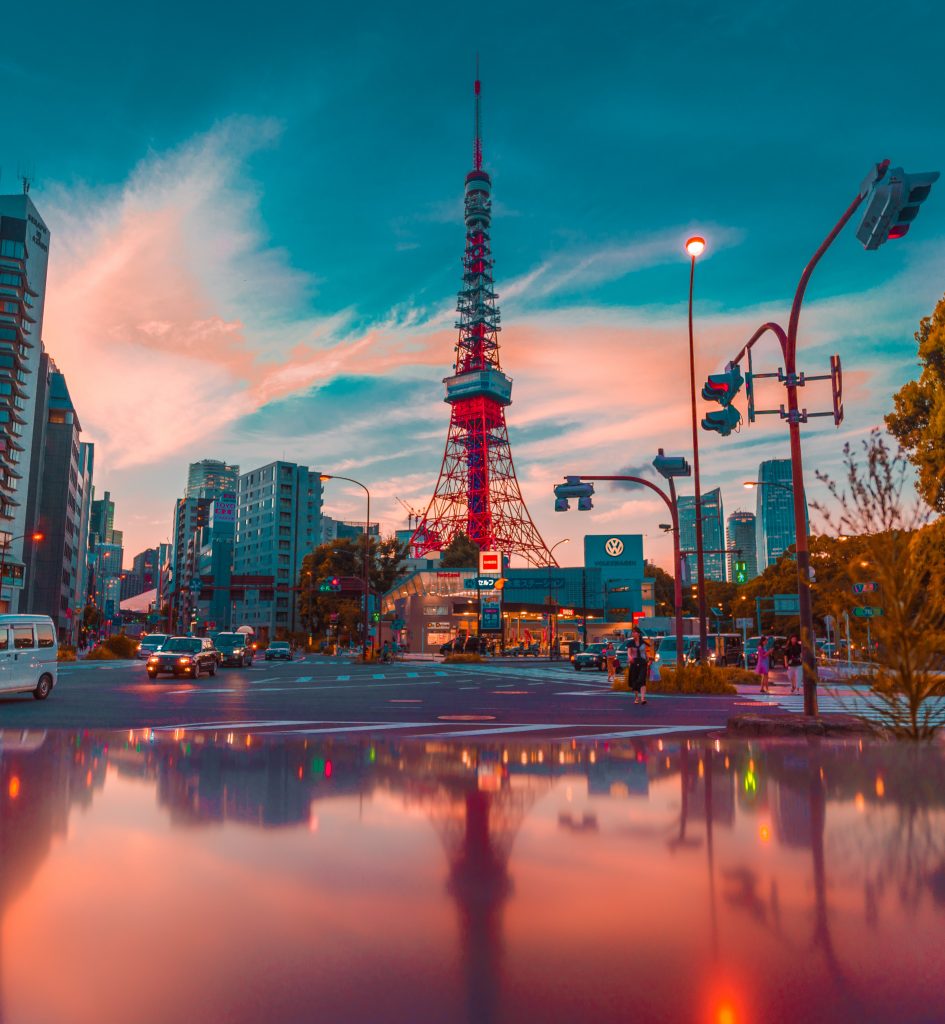
Shibuya Crossing
If you are looking for a “real Tokyo experience”, without a doubt Shibuya will never disappoint! The central hub is a shopping heaven for everyone. It boasts a number of giant shopping complexes such as Shibuya109 (super popular especially among young girls) and Shibuya Hikarie. But Shibuya is of course mostly known for its crosswalk. Shibuya Crossing – the busiest scramble crossing in the world. About 3,000 people cross it at a single time during the peak of rush hour! Shibuya is a place where you can easily spend a couple of hours and won’t get bored.
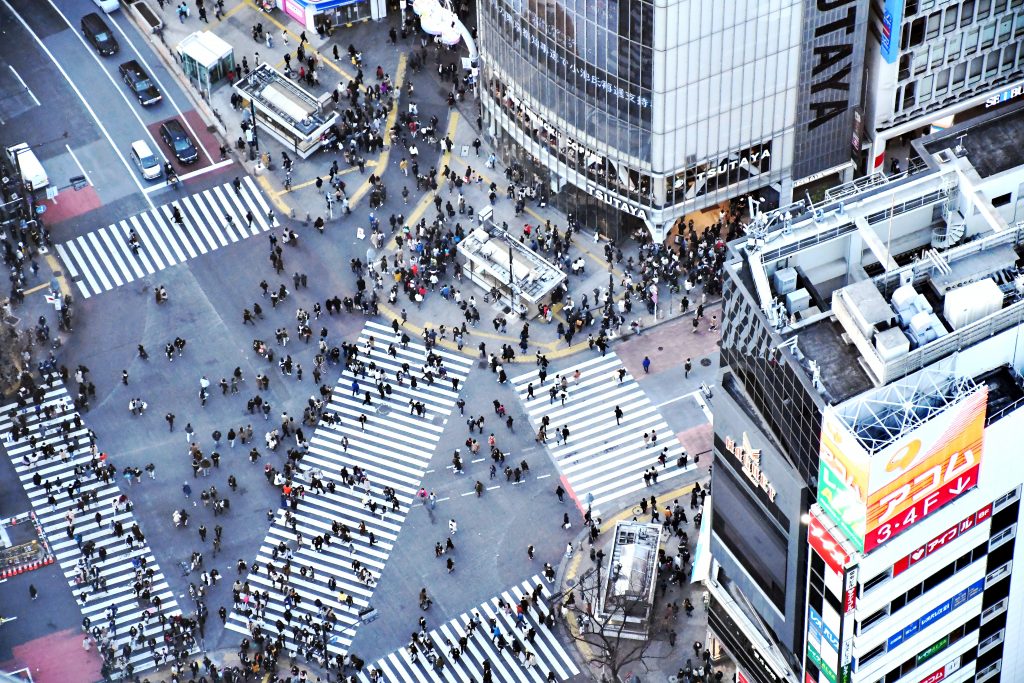
We recommend you combine Shibuya with a visit to Harajuku and Omotesando. Get to Shibuya Crossing around 4pm and visit the Shibuya Scramble Square. From the observation deck you can enjoy a panoramic view of the iconic crossing at a height of about 230m. Watching the sunset behind Mount Fuji and the neon lit buildings of Shibuya taking over the scenery is just amazing! Visiting Yoyogi Park after a long day will enable you to unwind and take a refreshing stroll in nature. Meiji Jingu Shrine is the world-famous sacred shrine. It was established in 1920 and was dedicated to the spirit of the late emperor Meiji and his wife.
Kyoto
It was the capital of Japan for more than 1,000 years, from 794 to 1868 AD. Kyoto literally translates as ‘Capital City’. Founded by one of Japan’s earliest emperors, who had himself moved the capital from Nagaoka-kyo. The city once only encompassed the immediate area around the Imperial Palace.
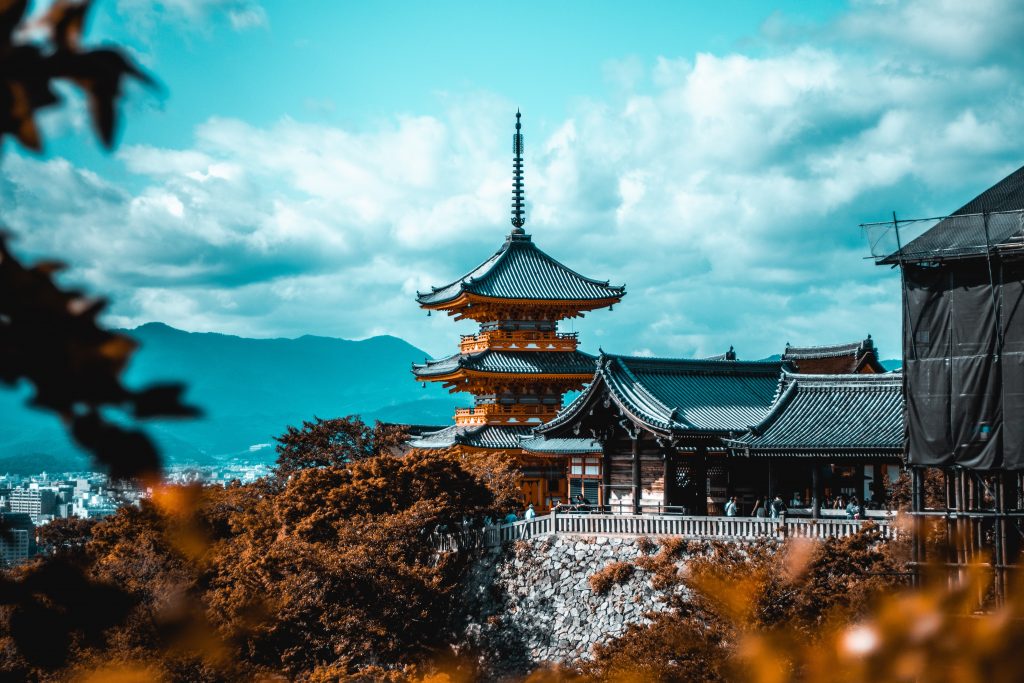
During the 19th century, Edo (now Tokyo) became a major trading hub with the west. While Kyoto maintained its isolationist policy. The capital transferred to Tokyo in 1868. Although since there was no official decree some maintain that Kyoto should still be considered the true capital.
City of Temples
Kamigamo Shrine is one of the most important Shinto sanctuaries in Kyoto; and the oldest too. It was founded on the banks of the Kamo River in 678 AD. It’s one of the 17 Historic Monuments of Ancient Kyoto and a UNESCO World Heritage Site. Its full name is Kamo-wakeikazuchi Shrine. Records from Emporer Heizei’s reign mention the Kamo-mioya jinga. It is mentioned as one of the only establishments granted a divine seal for use of documents.
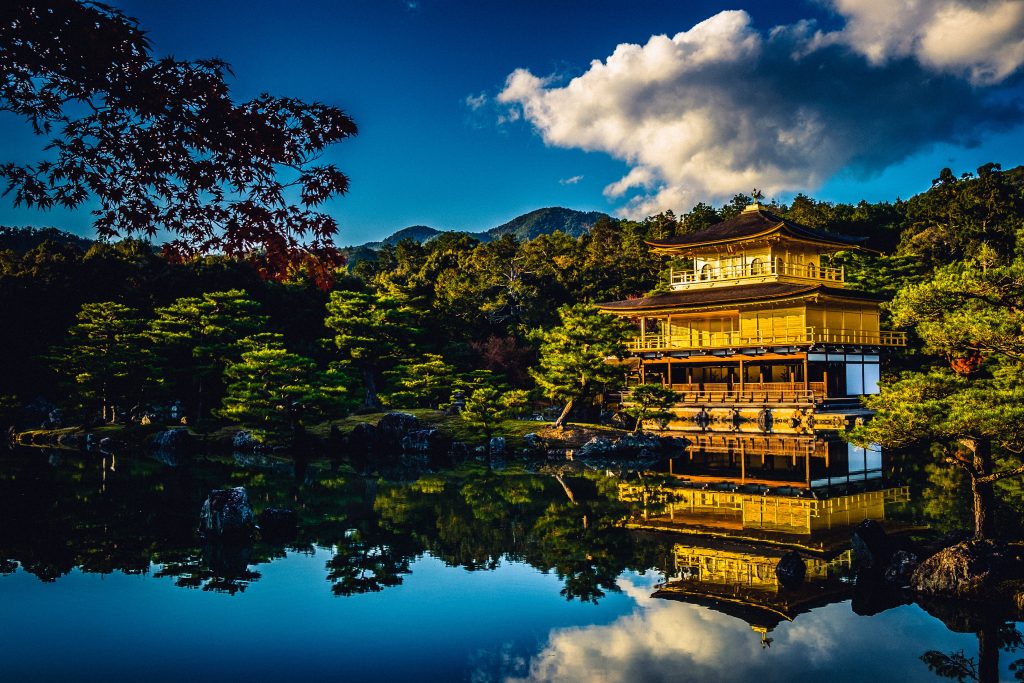
There are over 3,000 temples and shrines dotted around the city, hence its nickname ‘City of Ten Thousand Shrines’. Fushimi-Inari-Taisha is one of its iconic shrines, situated on the mountainside. Kiyomizu-dera is another of Kyoto’s most visited Buddhist temples. Founded in 778 AD, it encompasses various buildings and the main hall designed as a National Treasure.
Nijo Castle
Nijo Castle (Nijō-jō), complete with well-preserved walls, towers, and a moat, was built in 1603. Later it served as the seat of government. The complex has several buildings containing many significant works of art. It is famous as the location chosen by the emperor to issue the rescript abolishing the country’s once powerful Shogunate.
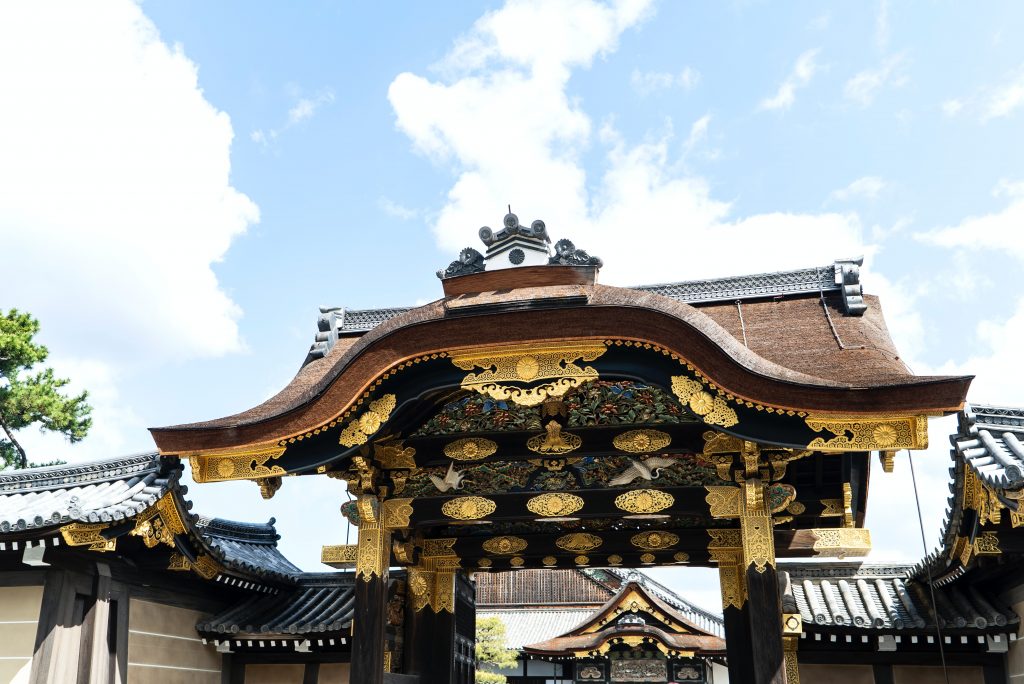
Highlights include the castle’s East Gate (Higashi Otemon, its main entrance). They also include the Inner Gate, or Karamon, notable for its fine carvings and decorated metalwork. Beyond this, the elaborate Mikuruma-yose is another must-see. The castle’s fine gardens are also fun to explore.
The site’s most important building is Ninomaru Palace. Consisting of five separate buildings linked by corridors; it boasts exquisite interiors decorated with many paintings by Kano Tanyu and his pupils. The principal apartment is the Hall of the Imperial Emissary(Jodan-no-ma). Matched in splendor by the adjoining rooms, Ni-no-ma and Tozamurai-no-ma with their paintings of tigers.
Fushimi-Inari Taisha Shrine
One of Japan’s most famous shrines, the Fushimi-Inari Taisha Shrine is a must-visit when in Kyoto. Founded in AD 711 and dedicated to the goddess of rice-growing, Ukanomitama-no-mikoto. The shrine is still frequented by merchants and tradesmen who pray for prosperity.
The main building dates from 1499 and features a spectacular four-kilometer-long avenue of bright orange “torii,” or arches; each dedicated by a business (it takes some two-hours to travel past the 1,000 arches lining the route). Also notable are its many sculptures of foxes, reputed to be messengers of the gods.
A great time to explore the shrine is at night. Not only will you be rewarded with a unique glimpse of this wonderfully illuminated heritage site; you’ll be rewarded with few if any crowds.
Kyoto Imperial Palace
The original Imperial Palace, built in AD 794 and replaced several times after being destroyed by fire. Remains one of the city’s most visited historic sites. Although the present building was constructed in 1855, it still impresses.
Occupying a large (once-walled) enclosure near the heart of the city; highlights include its finely decorated gates and important rooms and buildings. These include the Hall for State Ceremonies (Shishinden), the Emperor’s Residence (Seiryo-den), the Courtroom (Ko-gosho), and the Imperial Library.
While the lovely grounds of this Kyoto landmark are open to the public; the palace itself can only be visited as part of a guided tour operated by the Imperial Household Agency. Be sure to plan ahead and check their website for reservations and application forms.
The Kyoto National Museum and Municipal Museum of Art
In addition to its many fine old temples with their important artworks, it also boasts a number of impressive collections in its world-class museums and galleries. Perhaps the best known is the National Museum, an art gallery established in 1897 that is widely considered the most important such museum in Japan.
Focusing predominantly on pre-modern Asian art, particularly examples from Japan, the museum has been completely renovated and includes a new wing designed by architect Yoshio Taniguchi. Highlights of a visit include seeing numerous examples of historic art and applied arts, along with regular exhibitions (be prepared for plenty of walking).
Also worth seeing is Kyoto Municipal Museum of Art. Opened in 1928, this fine gallery features important works by Takeuchi Seihō, one of Japan’s leading artists of the 20th century.
Arashiyama Monkey Park
Perched atop a mountain in the tourist-heavy Arashiyama is one of the most interesting things to do in Kyoto; the Arashiyama Monkey Park. More than 100 snow monkeys call this park home, roaming freely amid the tourists who come to take a peek.
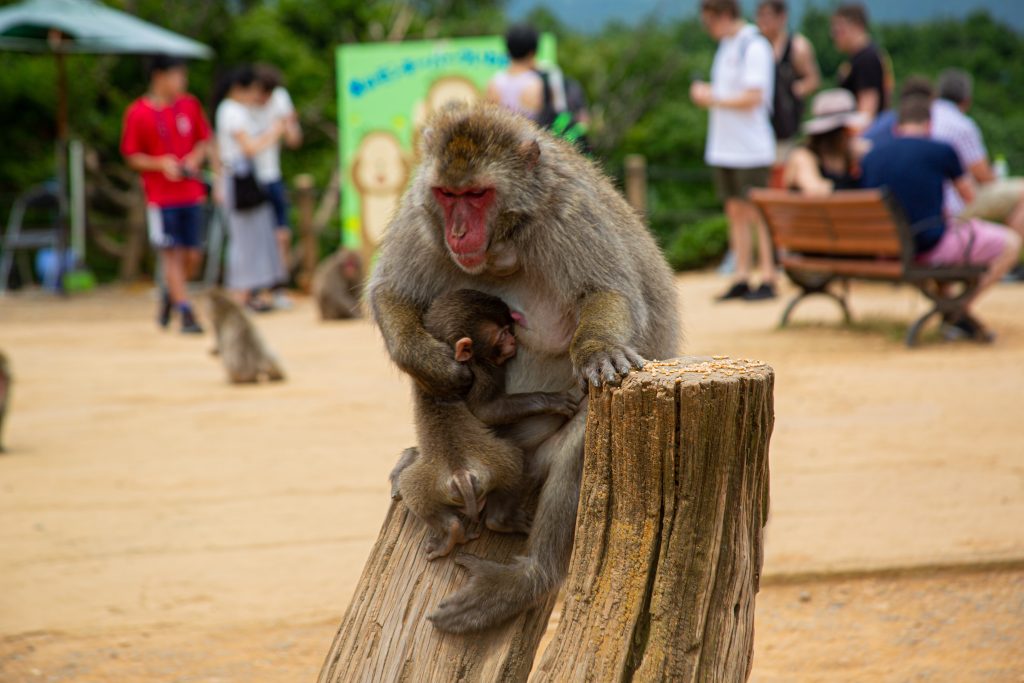
Getting so close to these wild creatures is a fascinating experience, but can also be a little unnerving, as the monkeys have no fear when approaching humans – especially if you’ve got a bit of food for them. The park features an enclosed area where you can buy bananas to feed to the monkeys. Don’t worry – they stay behind the fence. But they do grab, so proceed with caution.
Even if you aren’t interested in the monkeys, the top of the mountain has one of the best views of the city below. The walk up the hill takes about 30 minutes and is manageable for most levels.
Okinawa
Okinawa is a haven for divers, snorkelers and undersea explorers. The waters surrounding the islands are home to an abundance of coral reefs, natural sea caves and marine life. The beaches of Okinawa and most of the islands are mainly made up of various types of coral, which break up under the sea and are washed up on shore with the tide.
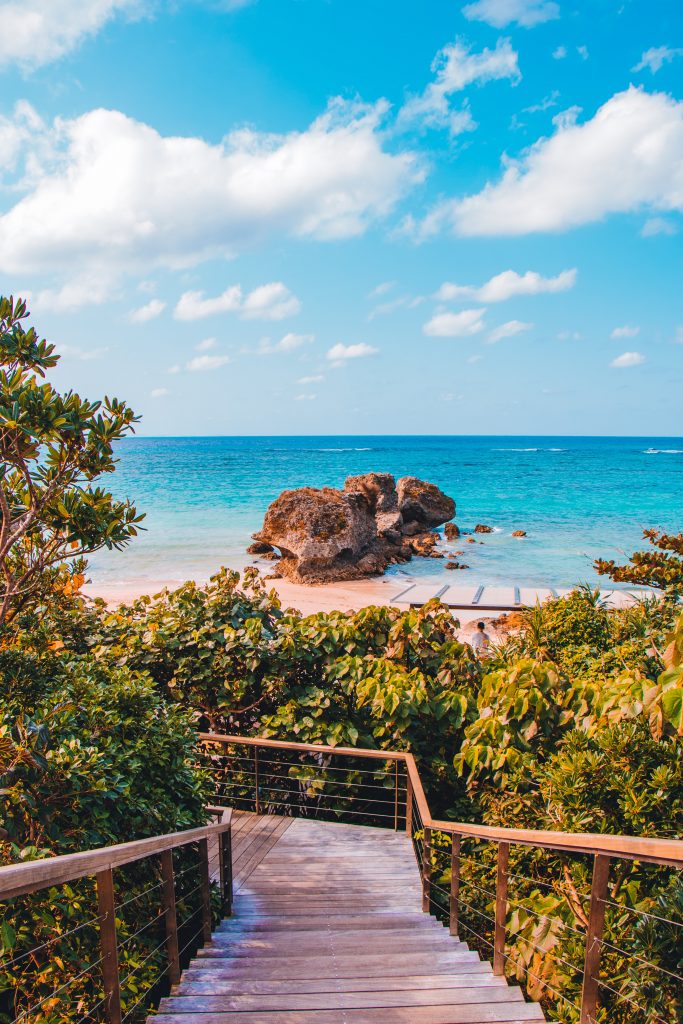
One type of coral, known as foraminifer shell, is particular famous for creating Okinawa’s ‘star sand’ beaches. When this coral dies, the tiny pointed shells gather on the shore, creating beaches of star-shaped sand.
Karate
Karate, one of the most well-known styles of martial arts in the world, developed in Okinawa (then known as the Ryukyu Kingdom) as a hybrid between traditional Chinese and Ryukyuan hand-to-hand combat techniques. This form of unarmed combat became widespread during the 1400s and 1600s. Most ordinary citizens were banned from obtaining weapons.
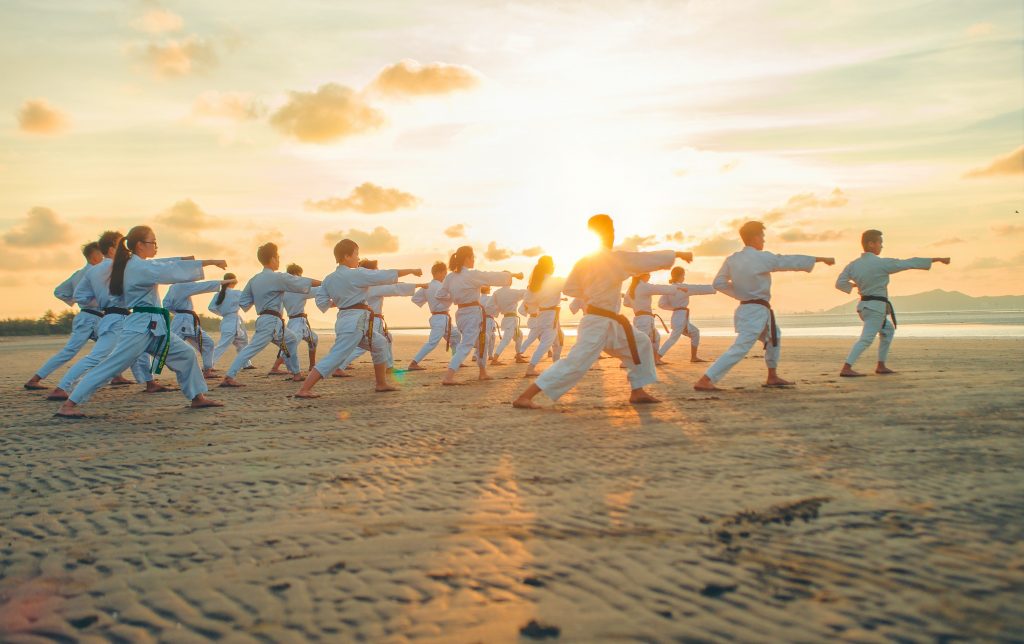
Karate was not introduced to mainland Japan until the early 1900s. At this time it began to gain popularity as an extracurricular among university students. Karate’s debut as an Olympic Sport is planned for 2020 at the Tokyo Olympics.
US Military Bases
After World War II, Okinawa came under US military rule, known as the United States Military Government of the Ryukyu Islands. It was during this time that the US government seized land to build military camps and training grounds, displacing hundreds of thousands of people from their homes.
Although Okinawa was handed back to Japan in 1972; these bases remain today under a security alliance between the Japanese and United States governments. Today, more than two thirds of all American military bases in Japan are located in Okinawa. The US Military uses ne fifth of the total land area of the main island.
Okinawa Guiness Book of Records
Many believe that the key to the Okinawans’ longevity is due to the clean, mineral-rich waters surrounding the islands. On Miyagi Island east of Naha in Uruma City, the Nuchi Masu (‘Salt of Life’) salt factory is renown for its natural sea salt, which is low in sodium and high in essential minerals.
In fact, in the year 2000, this salt was entered into the Guinness Book of World Records. It contained the most minerals with around 14 different types found inside. At Nuchi Masu, evaporating water is used to harvest the salt via fan. A technique patented by the factory which results in a more pure, mineral-rich salt.
Things to do in Okinawa
Shuri Castle
Shuri Castle or Shurijo Castle (首里城) is the most significant monument to present Ryukyu Kingdom which used to serve as a royal palace. After its destruction during the World War Ⅱ Battle of Okinawa in 1945, the castle was reconstructed in early 90s. Designated as the Castles of the Ryukyu Kingdom sites on the UNESCO World Heritage Site. It’s one of the most visited tourist sites in Okinawa today. Shuri Castle is located in Naha City, the capital of Okinawa Prefecture.
Churaumi Aquarium
Churaumi is the largest aquarium in Japan located at the Ocean Expo Park in the northern Okinawa Main Island. It is considered Japan’s best aquarium. It welcomed over 20 million visitors so far since opening in 2002.
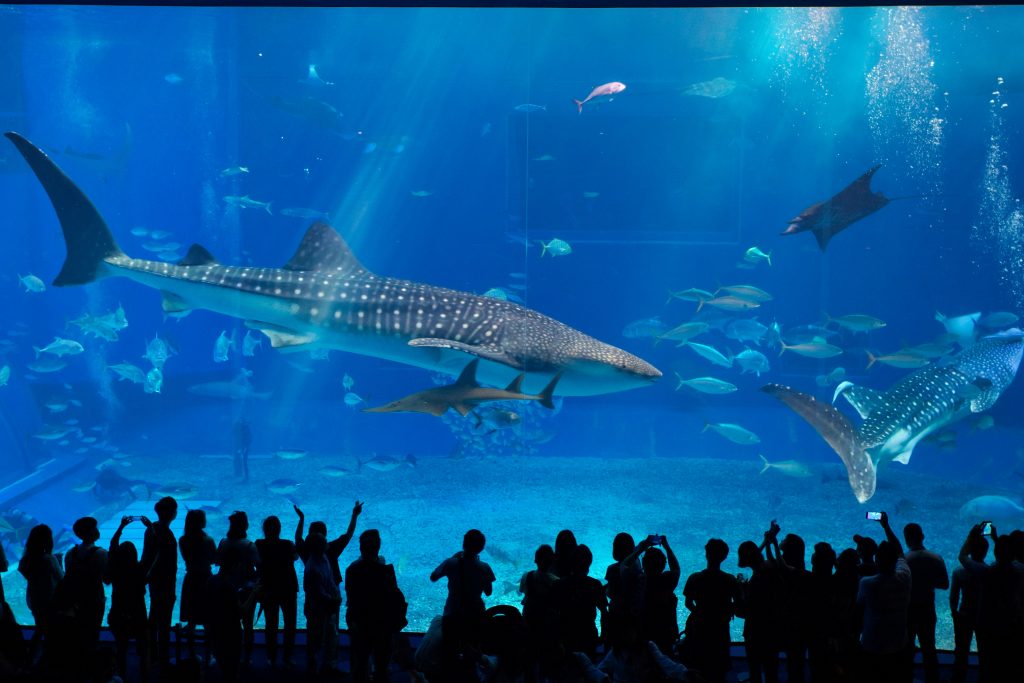
The best highlight of the aquarium is the Kuroshio Sea, the massive fish tank holds 7,500,000 liters of water with whale sharks, manta rays and hundreds of other sea creatures swimming freely. It’s one of the best tourist attractions in Okinawa on a rainy day.
Okinawa Peace Memorial
One of the most cruel battles during World War Ⅱ , the Battle of Okinawa has taken the place in Okinawa’s main island, causing a few hundred thousands deaths and huge destruction. Okinawa Peace Memorial Park is the memorial to the Battle of Okinawa which represents the history to remember.
The park is located in Itoman City at the southern tip of the main island of Okinawa. There are several more monuments within the area relating to the war memorial such as Peace Memorial Museum and Himeyuri Monument.
